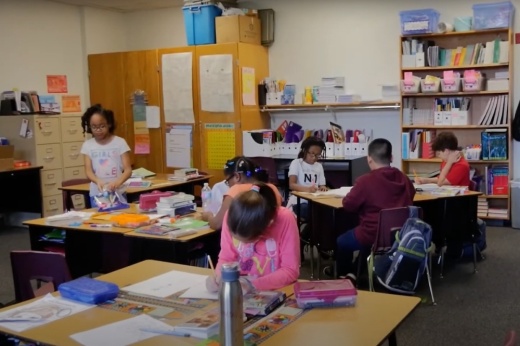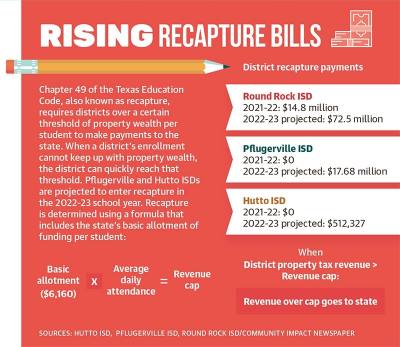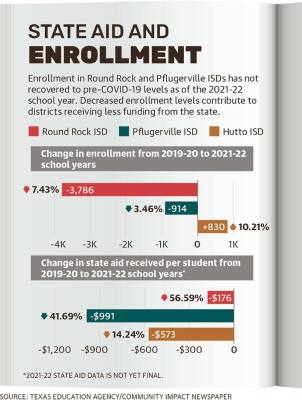Data from the Texas Education Agency indicates Round Rock and Pflugerville ISDs saw year-over-year enrollment drops of 5.2% and 3.65%, respectively, from the 2019-20 school year to the 2020-21 school year, with RRISD’s enrollment falling another 2.35% the following school year.
Slowed or declining enrollment in Round Rock and Pflugerville ISDs is in line with statewide trends. According to TEA data, statewide enrollment in public school districts dropped approximately 2.23% during the 2020-21 school year, a decrease that came following years of enrollment growth. In Hutto ISD, however, enrollment continued to grow relatively steadily in the 2020-21 school year.
District officials said declining enrollment numbers can bring—and in some cases already are bringing—a wealth of financial issues to school districts.
“Although the cost of living and inflation are going up, if we lost enrollment, then we have to function with less money,” RRISD Superintendent Hafedh Azaiez said.
Reasons for the drop
Officials say COVID-19 played a substantial role in the initial enrollment decline with many parents removing their children from public schools over safety concerns.“We’ve seen a lot more kids staying at home—like homeschool—[and] a lot more students also trying to find virtual options,” Azaiez said.
However, officials say that as concerns about COVID-19 wane, supply and affordability of housing have taken over as the main factors influencing enrollment.
Azaiez said recent high housing prices have led some families to move out of Round Rock and have kept new families from moving in at the same rate as previous years.
“I think that drove some of our parents to move up north of us, away from Round Rock, just to afford a rent or mortgage,” Azaiez said.
PfISD Superintendent Doug Killian echoed Azaiez’s points, listing the housing cost as a primary contributor to PfISD’s drop in enrollment.
Killian also pointed to the growing network of charter schools in the area creating additional competition for school districts.
Sarah Gardner, director of community engagement for Meridian World School, a public charter school in Round Rock, said after some initial enrollment instability at the beginning of the pandemic, Meridian’s enrollment has remained stable.
“We have about a 2,500-person waitlist, so we’re really able to draw on that waitlist if a student unenrolls or moves,” Gardner said.
Nearby in HISD, enrollment has continued trending up: From 2019-20 to 2021-22, HISD’s enrollment grew 10.21% while RRISD and PfISD saw net declines of 7.43% and 3.46%, respectively.
HISD Superintendent Celina Estrada Thomas said Hutto’s rapidly growing population and relative affordability is a primary reason for the district’s more stable enrollment.
“The housing market in Hutto continues to be attractive for young families,” Estrada Thomas said. “The availability of housing and the low interest rates kept families moving into our area.
Budgetary concerns
When enrollment levels decline, Killian said school districts primarily feel the shortfall in their budgets.“Low enrollment and attendance have a significant impact on us as a district in a variety of ways, but most importantly in loss of state aid,” Killian said.
In Texas, the amount of property tax a district is allowed to keep as well as the amount of state aid it receives are based on the number of students who regularly attend school.
Low enrollment means fewer students attending school than were projected on a district's budget for any given school year. That can dramatically reduce the amount of funding a school district has to work with.In PfISD, for example, the district budgeted for 26,312 students, but the total enrollment ended up at 25,486 for the 2021-22 school year. That deficit contributed to a $7.6 million shortfall. Officials said the drop in enrollment helped increase the deficit at PfISD, and the district will likely end the year short about $12.9 million.
Killian said budget shortfalls have necessitated measures including personnel reductions and delaying the opening of Hidden Lake Elementary School, which was initially scheduled to open in time for the 2022-23 school year.
Similarly, Azaiez said declines in enrollment in RRISD are causing issues that could continue to affect staff retention.
“It made it hard for us to increase compensation—to continue retaining our great teachers and staff, but also, if we have vacancies, to recruit,” Azaiez said.
Further, when a district raises more in property taxes than its average daily attendance allows for, its excess revenue goes to the state in a process known as recapture.
RRISD is in recapture—the district is projected to send $72.5 million to the state in the 2022-23 school year, up from a $14.8 million recapture bill in the 2021-22 school year.
According to district budget materials, HISD also expects to enter recapture in 2022-23 with a projected bill of $512,327.
PfISD is on track to enter recapture next school year as well, according to Chief Financial Officer Jennifer Land, paying a projected $17.68 million in 2022-23.
The way forward
Enrollment levels in PfISD have already begun to increase, and projections from RRISD show its enrollment back on the upswing in 2022-23 as well.This is due in part to recent action on the district level. For instance, in June, RRISD trustees approved a pilot open enrollment program that will allow students living outside the district to enroll in select RRISD schools.
“I expect to have some students coming back to Round Rock from outside school districts,” Azaiez said. “I hope that once more parents know about [the open enrollment program] and it’s been more successful, maybe we can expand it, and we can see even more students actually enrolling in Round Rock from outside ISDs.”
However, Killian and Azaiez both stressed the importance of action at the state level.
Specifically, they said an increase in the basic allotment—the amount of funding a district is allowed per student in average daily attendance—will be necessary for their respective districts’ financial well-being.
“We need legislative help,” Killian said. “School districts have asked multiple times for our Legislature to increase the basic allotment.”
Will Holleman, senior director of government relations for education advocacy group Raise Your Hand Texas, said if the basic allotment is not regularly increased, districts must rely more and more on local property taxes for funding.
“The way that the basic allotment works, if you’re not raising that to keep up with inflation or other types of costs that are coming to the district, essentially you’re reducing the overall state aid to districts year on year,” Holleman said.
The most recent basic allotment increase came in 2019, when House Bill 3 raised the basic allotment from $5,140 to $6,160.
Azaiez said RRISD will continue to look for ways to leverage its existing resources while holding out for legislative action on the basic allotment for his district.
“That’s the hope, but we’re not going to just sit and do nothing,” Azaiez said.







